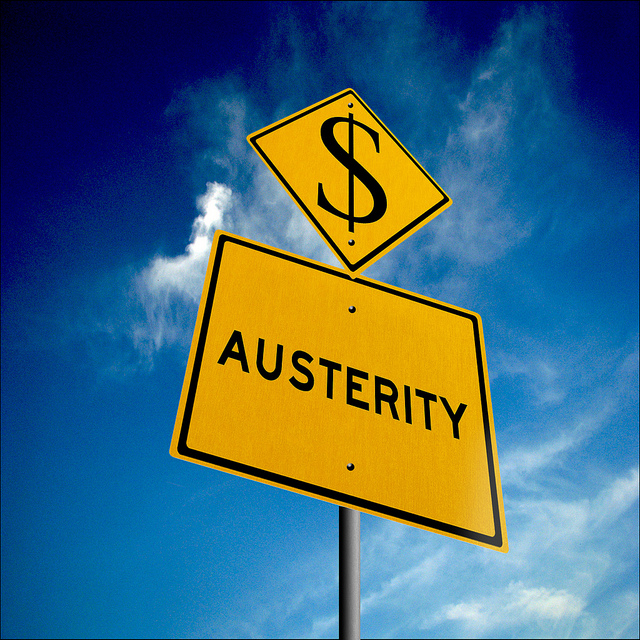Here in Ontario, we have glimpsed the future, and it looks a lot like Austerity 2.0.
That’s what Ontario Premier Kathleen Wynne’s mandate letters set out for her cabinet last week.
On the one hand, the premier is instructing her ministers to invest — in poverty reduction, transit and transportation improvements, and (hopefully) job creation.
But, with those same letters, ministers are being told to hold the line on spending. Even after two years of her predecessor’s austerity cuts, Wynne has instructed her cabinet to find $250 to $500 million in savings every year until 2017-18 — her target to eliminate the province’s fiscal deficit.
So, Austerity 2.0.
A recent report from the Conference Board of Canada asks a question that I’ve been asking for some time: Can Wynne’s government have it both ways? Can they hold the line on spending while investing in essential public services? Can they be an activist government while simultaneously eliminating the deficit?
It’s a delicate balancing act to perform. But without a conversation about new revenue tools, or even about which public programs will be cut and by how much, many are left wondering which goal will be abandoned first.
And, I wonder, is this all really necessary in the first place?
When Finance Minister Charles Sousa released the 2013-14 public accounts last week, he announced a deficit of $10.5 billion – $800 million less than was forecast two months earlier in the 2014 budget, and $1.3 billion less than the 2013 budget forecast.
And just how did the deficit come to be $10.5 billion this year? Through a not-so-straightforward series of revenue shortfalls and additional reductions in spending in most program areas.
For example: educational spending came in $600 million below plan; post-secondary education and training came in $200 million below plan. Children’s and social services? $300 million below plan. Other services — another $300 million below plan. Health care and justice services saw small increases of $100 million each, following health care spending cuts of $800 million in 2012 and $1.1 billion in 2011.
With all of this under-budget spending, you may be wondering why the deficit wasn’t even smaller. Part of the problem is lower than forecast personal income tax revenue and sales tax revenue — $2 billion lower to be exact.
That means tax contributions from working Ontarians weren’t as robust as predicted and consumers weren’t buying as much as the government had hoped.
Here’s the thing: Ontario’s deficit would have been even further below forecast if workers’ wages were increasing faster or if more Ontarians were working.
One avenue for increasing total compensation is to increase wages. According to Statistics Canada Labour Force Survey data, median weekly wages grew by 1.2 per cent in 2013. That’s the lowest growth rate since 1999. In fact, no matter which way you slice it — full-time vs. part-time, average vs. median, weekly vs. hourly – wage growth in Ontario was dismal in 2013.
A second avenue for increasing compensation is to create jobs — something Ontario did not do terribly well in 2013. The province added 94,400 net new jobs in 2013 — one-third of which were part-time. Another 13 per cent came in the form of self-employment, which typically pays lower than regular work.
Preferably these two avenues would be pursued in tandem. Government has not exactly been a role model on either front. When government decided to freeze the wages of almost 400,000 workers between 2012 and 2013, it sent a signal to the private sector that the economy just can’t support higher wages, despite the tax cuts of 2009 that were meant to spur business investment and wage increases. Essentially, government set a very low bar for the private sector.
Furthermore, by sidestepping a conversation about an appropriate benchmark for the minimum wage and instead simply adjusting it for inflation since 2010 (when it was last adjusted), the Ontario government signaled to the private sector that the bar was not going to be raised any time soon.
There is, however, widespread agreement that one of the main culprits of slow growth, and consequently slow growing government revenues, is a lack of aggregate demand. This lack of demand could be addressed with higher wages at the lower end of the wage spectrum — those who make minimum wage and those who work in the private sector. By setting the bar as low as it has, government is actually perpetuating the problem instead of solving it.
It’s a vicious circle that leads to slow wage growth and a slower decline in the provincial deficit.
There is a simple alternative to austerity 2.0: the province could stop being held hostage to an arbitrary balanced budget date.
Who decided that 2017-18 was the year that the budget had to be balanced? And who decided that it had to be balanced with spending cuts and token tax increases?
What’s the fascination with program spending cuts if they come at the expense of the quality of public services and quality of life?
Ontario is subject to historically low interest rates. Borrowing now to invest in long underfunded public services like public transit and post-secondary education makes good economic sense.
Furthermore, if the political decision is that the deficit beast must be slayed in the next three years, there is more than one way to do it. Instead of cutting spending, to the detriment of the services Ontarians rely on every day, the province could raise taxes, as the CCPA-Ontario has discussed here, and here and here.
The future doesn’t have to be a milder variation of perma-austerity. There are other options. It’s time to expand our thinking on this front.
Kaylie Tiessen is an economist with the Ontario Office of the Canadian Centre for Policy Alternatives (CCPA Ontario). Follow her on Twitter @KaylieTiessen
Photo: 401(K) 2012/flickr



